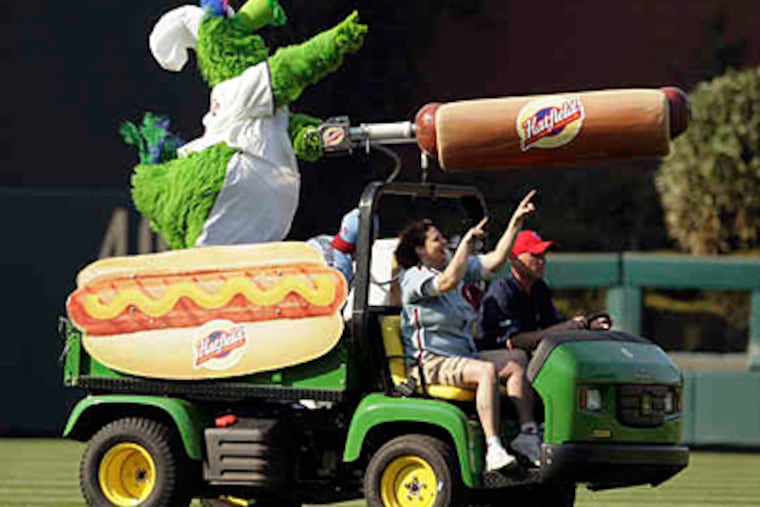More mustard for Phanatic's hot dog gun
As the Phillies embark on another defense of their National League crown, let us pause for a scientific analysis of their firepower.

As the Phillies embark on another defense of their National League crown, let us pause for a scientific analysis of their firepower.
We speak not of the mighty bats of Howard and Utley, but of actual firepower:
The hot dog launcher.
The curious propulsion device, wielded at select home games by the Phillie Phanatic, got its annual tuneup last week and was in action for the first time this season.
A tank of compressed nitrogen. Projectiles of processed protein. A shaggy, green creature smacking the "fire" button. What's not to like?
Explosive yet elegantly simple, this bazooka of beef was cooked up by Hatfield Quality Meats and CHL Systems, an engineering and manufacturing firm in Souderton.
Other gas-powered launchers are out there, used for shooting hot dogs or T-shirts, and there is some disagreement about who made one first. But in its current incarnation the Phanatic's launcher - with its six-foot barrel encased in a giant replica of a ballpark frank - is one of a kind.
A previous version of the device relied on pressurized carbon dioxide to send the hot dogs skyward. The switch to nitrogen was made to provide more "oomph," said CHL vice president Kevin Landis.
More later on that topic - it's a little more complicated.
But suffice it to say that the launcher makes a big noise.
Last Monday, Hatfield's Eric Haman was behind the scenes at Citizens Bank Park, replacing a leaky brass fitting and test-firing the device (with no hot dog loaded in the chamber).
"BANG! BANG!" it went, the noise echoing off the concrete walls in the bowels of the stadium.
Haman's title is corporate communications manager, but since he oversaw the upgrade of the Phanatic's big blaster, its maintenance has now been added to his list of duties. He jokes that he should add "Manager of Ballistics" to his business card.
The launcher's outer shell - the fiberglass replica of a hot dog - was made in Hatfield's machine shop. The inner workings are the product of mechanical engineers at CHL.
When you hit the fire button, it sends rapidly expanding gas through a pilot valve. This in turn opens a larger "dump valve," transmitting the nitrogen into the main fire chamber. While air pressure is about 14.7 pounds per square inch at sea level, the pressure from the gas measures 250 to 300 pounds per square inch. That pushes the hot dog out of the aluminum barrel in a hurry.
How fast? It's not enough to injure someone in the stands, especially since a hot dog's aerodynamics are poor, making it slow way down soon after firing.
But it's fast enough that if the wieners and buns weren't wrapped in paper and duct tape, they would disintegrate - as happened during some messy test rounds.
A rough calculation shows an initial muzzle velocity of at least 200 feet per second - more than 135 miles an hour. (In a single frame of video footage lasting one-thirtieth of a second, the dogs appear to travel about seven feet at the outset.)
Landis said designing the device was fairly straightforward for his engineers, as the company does lots of work with pneumatic equipment.
"It was right up our alley," he said.
The new model debuted in 2004, with the new ballpark, and is so big it has to be mounted on a small truck. The previous launcher, which used carbon dioxide and was handheld, dated to 1996.
A Canadian company that makes a similar product, called the Master Blaster, claims it came up with the idea first, though company president Brian Glow could not provide a precise date. The folks in Philly good-naturedly insist that they started it.
In any event, unlike the Master Blaster, Hatfield's howitzer now uses nitrogen.
About the switch: Robert Levis, chairman of Temple University's chemistry department, said the change from carbon dioxide shouldn't make much difference in firing just one shot. It's the pressure that matters.
But for repeated firing, he said, nitrogen has the edge. The gas is fed to the launcher from a storage tank, in which the pressure measures more than 2,000 pounds per square inch.
At room temperature, however, carbon dioxide turns to a liquid well below that pressure, at 1,000 p.s.i. In order to replenish the launcher after the first shot, you'd have to wait for some of the liquid to evaporate. The evaporating CO2 also cools the tank, and lowers the pressure for a while until the tank heats back up, the chemist said.
"You're just not going to get that many rapid-fire shots with the CO2 in comparison with the same amount of nitrogen," Levis said.
So what does the big green guy think? Tom Burgoyne, the human being who gives life to the mascot at the ballpark, said the launcher has been able to send its payload to the highest reaches of the stadium. He maintains that fans like catching the tasty meat missiles as much as they do a foul ball.
"The Phanatic is reaching out, trying to feed our hungry fans," he said.
The device was in action during Thursday's game against the Nationals. The team's own firepower fell short for a change, as the Nationals won 7-5.
But the launcher still delivers. Levis, who has seen the thing in action, appreciates it on multiple levels.
"This is the culinary equivalent of bungee jumping. Not an efficient means of getting from point A to B," he said, but "fun to watch."